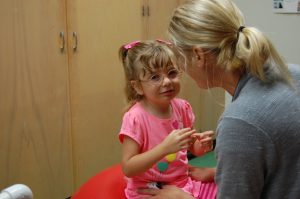
By Samantha Zauner
While a EIVI professional works primarily on vision related skills, it is also imperative that they collaborate with other providers. The occupational therapist (OT) and physical therapist (PT) are often a part of the early intervention team when a child has a visual impairment. OTs and PTs offer much to the team since they are trained on muscle tone and proper positioning. Muscle tone development is often significantly impacted by a child’s visual impairment, as their motivation to move is greatly reduced as a result of the lack of visual stimuli. The role of the EIVI professional is to provide support to the family and other team members. If other team members have not worked with a child with a visual impairment they may not be knowledgeable about the adjusted developmental milestones or may set goals and/or strategies that are inappropriate based on the typical development of children with visual impairments. As an EIVI professional, you play an imperative role in assisting other team members with modifications or adaptions to activities and strategies, to ensure that the child’s visual impairment is being considered.
One area of muscle tone that the EIVI professional can assist the early invention team in, is the rotation motion both while lying in the supine position and sitting position (Ferrell, 2011, pp.131-198). The rotation motion is the ability to turn one body part without turning all body parts, and is an important part of motor development. Ferrell cautions that “(t)he rotation ability is often overlooked and taken for granted.” It is important to always take into consideration the child’s level of visual impairment. For example, if a child has very low vision, therapists must pay greater attention to body rotation and positioning.
While motor development is important for all children it is an imperative skill for children with very low functional vision. Knowing that motor development is an additional area of need, the support of an OT is imperative for the team. An OT can provide information on a child’s motor development that will help the EIVI professional determine the appropriate selection of a learning media (large print, braille, or auditory) for the child. An example of when this input would be needed is if the team is considering braille instruction for a child who also diagnosed with Cerebral Palsy. The OT could conduct testing in the areas of tone and fine motor (Goodman, 2003). The PT is able to help determine the best positioning for the child to ensure proper posture and trunk support, while also considering their visual access to their environment (Chen, 2014).
In conclusion, it is imperative that all teammates on an IFSP team collaborate with one another to ensure the child and the family receives the best outcomes possible. In addition it is the EIVI professional’s responsibility to ensure all members of the team understand the implications of the child’s visual impairments and assist with brainstorming for additional adaptations or considerations that need to be in place.
Resources
Chen, D. (2014). Essential elements in early intervention: Visual impairment and multiple disabilities. New York, NY, NY: AFB Press.
Ferrell, K. A. (2011). Reach out and teach: Helping your child who is visually impaired learn and grow. New York, NY: AFB Press.
Goodman, S. A., & Wittenstein, S. H. (2003). Collaborative assessment: Working with students who are blind or visually impaired, including those with additional disabilities. New York, NY: AFB Press.